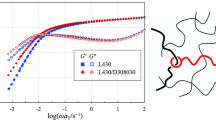Abstract
The dynamics of the individual components in 1,4-polyisoprene/polyvinylethylene (PIP/PVE) miscible blends are studied using dynamic stress-optical measurements. While the homopolymers are thermorheologically simple and obey the stress-optic rule, the blends show failure of time-temperature superposition and complex stress-optic behavior. The way in which the stress-optic rule fails reveals the relaxation dynamics of each species. The dynamic modulus and complex birefringence coefficient are analyzed to infer the relaxation of each component. The entanglement molecular weight, M e , and monomeric friction coefficient, ζ0, of each species as a function of blend composition and temperature are determined from the contribution of each species to the dynamic modulus. The effect of blending on M e of each component is small; however, its effect on ζ0 of each species is dramatic. Blending strongly speeds the rate of relaxation of the high T g component (PVE), while more modestly slowing the relaxation of the low T g component (PIP). The dynamics of each species have different temperature dependencies in the blend, which leads to the failure of the superposition principle. Furthermore, both the difference between the friction coefficients of the two species and the difference in their temperature dependencies is greater in blends rich in the high T g material (PVE).
Similar content being viewed by others
References
Carella JM, Graessley WW, Fetters LJ (1984) Effect of chain microstructure on the viscoelastic properties of linear polymer melts: polybutadienes and hydrogenated polybutadienes. Macromolecules 17:2775–2786
Chung GC, Kornfield JA, Smith SP (1994) Component dynamics in miscible polymer blends: a two-dimensional deuteron NMR investigation. Macromolecules 27:964–973
Colby RH (1989) Breakdown of time-temperature superposition in miscible polymer blends. Polymer 30:1275–1278
Composto RJ, Kramer EJ, White DM (1988) Mutual diffusion in the miscible polymer blend polystyrene/poly-(xylenyl ether). Macromolecules 21:2580–2588
Composto RJ, Kramer EJ, White DM (1990) Reptation in polymer blends. Polymer 31:2320–2328
Doi M, Edwards SF (1986) The theory of polymer dynamics. Clarendon, Oxford
Doi M, Graessley WW, Helfand E, Pearson DS (1987) Dynamics of polymers in polydisperse melts. Macromolecules 20:1900–1906
Ferry JD (1980) Viscoelastic properties of polymers. Wiley, New York
Fischer EW, Zetsche A (1992) Molecular dynamics in polymer mixtures near the glass transition as measured by dielectric-relaxation. ACS Polymer Preprints, Spring, San Francisco 78
Gotro JT, Graessley WW (1984) Model hydrocarbon polymers: rheological properties of linear polyisoprenes and hydrogenated polyisoprenes. Macromolecules 17:2767–2775
Janeschitz-Kriegl H (1983) Polymer melt rheology and flow birefringence. Springer-Verlag, Berlin
Kannan RM, Kornfield JA (1992) The third-normal stress difference in entangled melts: quantitative stress-optical measurements in oscillatory shear. Rheologica Acta 31:535–544
Kannan RM, Kornfield JA (1994) Stress-optical manifestations of molecular and microstructural dynamics in complex polymer melts. To appear in Journal of Rheology
Kornfield JA, Fuller GG, Pearson DS (1991) Third normal stress difference and component relaxation spectra for bidisperse melts under oscillatory shear. Macromolecules 24:5429–5441
Larson RG (1988) Constitutive equations for polymer melts and solutions. Butterworths, Boston
Lau S, Pathak J, Wunderlich B (1982) Study of phase separation in blends of polystyrene and poly(α-methyl-styrene) in the glass transition region using quantitative thermal analysis. Macromolecules 15:1278–1283
LeMenestrel C, Kenwright AM, Sergot P, Lauprêtre F, Monnerie L (1992) 13C NMR investigation of local dynamics in compatible polymer blends. Macromolecules 25:3020–3026
Mark JE, Eisenberg A, Graessley WW, Mandelkern L, Koenig JL (1984) Physical properties of polymers. American Chemical Society, Washington, DC
Miller JB, McGrath KJ, Roland CM, Trask CA, Garroway AN (1990) Nuclear magnetic resonance study of polyisoprene/poly(vinylethylene) miscible blends. Macromolecules 23:4543–4547
Ngai KL, Plazek DJ (1990) Breakdown of time-temperature superposition in miscible polymer blends and the coupling scheme. Macromolecules 23:4282–4287
Osaki K, Takatori E, Kurata M, Ohnuma H, Kotaka T (1986) Birefringence of a block copolymer solution in the stress relaxation process. Polymer J 18:947–954
Roland CM (1987) Entropically driven miscibility in a blend of high molecular weight polymers. Macromolecules 20:2557–2563
Roland CM (1988) Rheology of a miscible polymer blend. Journal of Polymer Science, Polymer Physics Edition 26:839–856
Roland CM, Ngai KL (1991) Dynamical heterogeneity in a miscible polymer blend. Macromolecules 24:2261–2265
Roovers J, Toporowski PM (1992) Microheterogeneity in miscible blends of 1,2-polybutadiene and 1,4-polyisoprene. Macromolecules 25:3454–3461
Rubinstein M, Helfand E, Pearson DS (1987) Theory of polydispersity effects on polymer rheology. Binary distribution of molecular weights. Macromolecules 20:822–829
Struglinski MJ, Graessley WW (1985) Effects of polydispersity on; the linear viscoelastic properties of entangled polymers. 1. Experimental observations for binary mixtures of linear polybutadiene. Macromolecules 18:2630–2643
Tomlin DW, Roland CM (1992) Negative excess enthalpy in a van der Waals polymer mixture. Macromolecules 25:2994–2996
Trask CA, Roland CM (1989) A nearly ideal mixture of high polymers. Macromolecules 22:256–261
Tsenoglou C (1989) Viscoelasticity and self-diffusion in miscible heteropolymer blends. New trends in physics and physical chemistry of polymers. Plenum 375–383
Wu S (1989) Chain structure and entanglement. Journal of Polymer Science, Polymer Physics Edition 27:723–741
Zawada JA, Ylitalo CM, Fuller GG, Colby RH, Long TE (1992) Component relaxation dynamics in a miscible polymer blend: poly(ethylene oxide)/poly(methyl methacrylate). Macromolecules 25:2896–2902
Zawada JA, Fuller GG, Colby RH, Fetters LJ, Roovers J (1994) Measuring component contributions to the dynamic modulus in miscible polymer blends. To appear in Macromolecules
Zetsche A, Kremer F, Jung W, Schulze H (1990) Dielectric study on the miscibility of binary polymer blends. Polymer 31:1883–1887
Zhao Y, Jasse B, Monnerie L (1989) Orientation and relaxation in uniaxially stretched poly(methyl methacrylate)-poly(ethylene oxide) blends. Polymer 30:1643–1650
Author information
Authors and Affiliations
Rights and permissions
About this article
Cite this article
Arendt, B.H., Kannan, R.M., Zewail, M. et al. Dynamics of each component in miscible blends of polyisoprene and polyvinylethylene. Rheola Acta 33, 322–336 (1994). https://doi.org/10.1007/BF00366959
Received:
Revised:
Issue Date:
DOI: https://doi.org/10.1007/BF00366959




